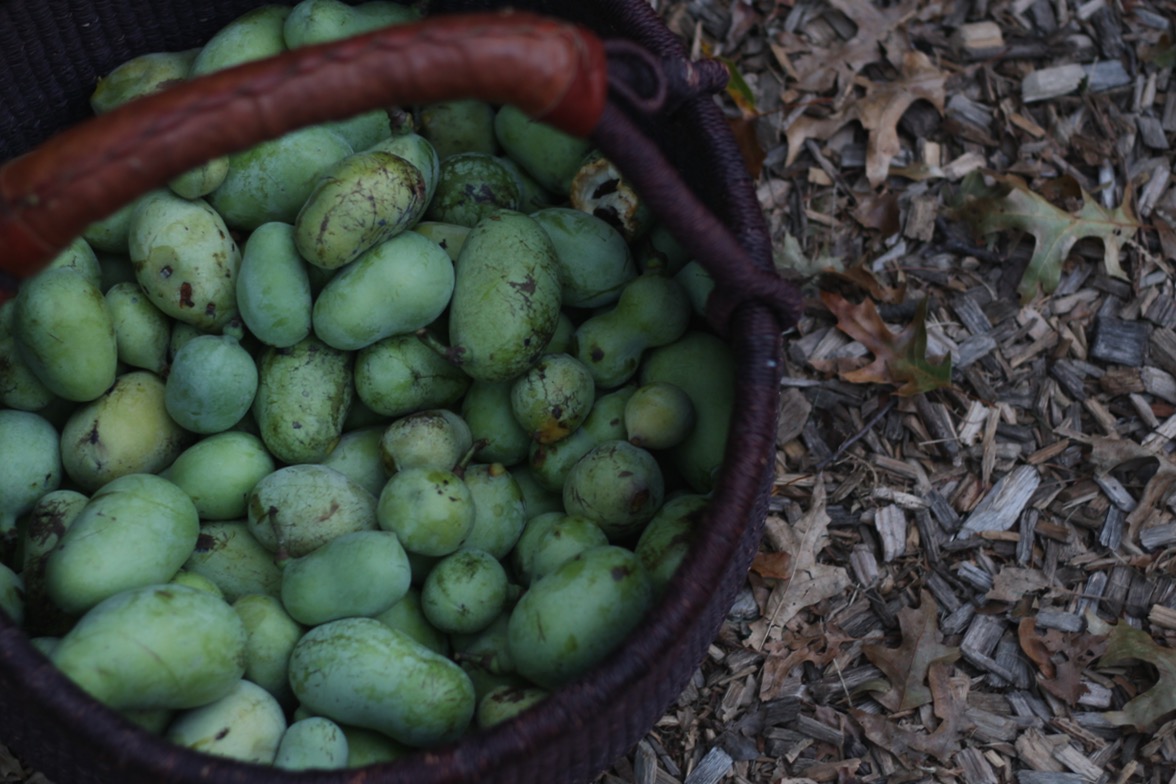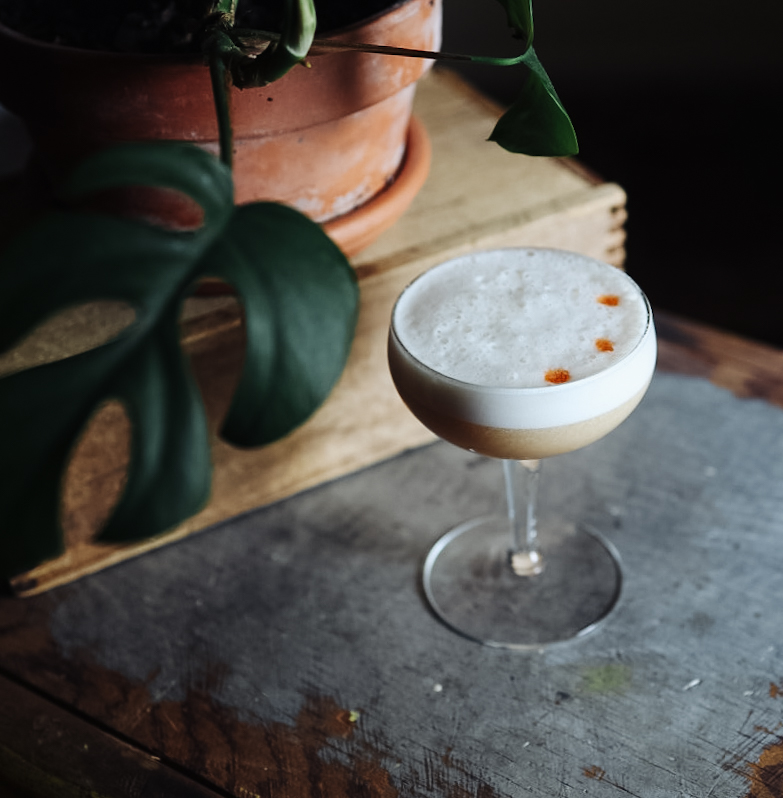Meet the bartender-botanist committed to reviving this humble native fruit.

One of my favorite parts of working as a bartender is introducing people to new flavors and ingredients. Sometimes, these come in the form of a spirit, beer or wine. Other times, it’s a cocktail. The most exciting, for guests and staff alike, are local ingredients foraged from the wilds of southern New Jersey (where I work at The Farm and the Fisherman), as it gives us an opportunity to let people taste something that may be growing in their backyard or not far beyond it.
It’s not uncommon to see ingredients on our menu such as elderflower, staghorn sumac, dandelions, black walnut, sassafras, wild blueberries and juniper; however, the wild ingredient that brings me the most joy to share with people is pawpaws, because in spite of the fact that they are America’s largest native fruit (and perhaps its most delicious), the vast majority of the general population have never even heard of them. Once they’ve had their first taste, I see their eyes light up as they try to wrap their heads around how an ingredient that tastes so tropical—with flavors that are like a cross between mango, banana and pineapple—could possibly grow here.
As it turns out, pawpaws do have tropical origins. They belong to the Asimina genus of the Annonaceae family of flowering trees and are closely related to other Central and South American tropical fruits including soursop (aka guanabana), sweetsop and cherimoya. Pawpaws branched off from this family tree around 56 million years ago in the southern US, near what is today the Mexican border. With the help of now extinct megafauna, such as giant sloths and wooly mammoths, and later, ancient Native American populations, the fruit made its way east of the Mississippi where it can now be found growing from northern Florida to southern Ontario.
Pawpaws usually grow to around 25 feet in height and establish patches by sending up new trees via underground runners. Although all of these runners are genetically identical, pawpaws still require another variety in order to pollinate and set fruit. Since pawpaws evolved before bees and eudicots (true flowering plants), they rely on other, less common pollinators such as flies and beetles for fertilization. The fruits, which are technically berries, grow to between three and six inches long and consist of thin green skin encapsulating custard-like yellow pulp and large black seeds. Their window of availability is typically late August to early October.
Historically, pawpaws have gone by many names, including Indian banana, Quaker delight, hillbilly mango, custard apple and, most recently, hipster banana, alluding to their importance in many different cultural groups. They were an incredibly important food source for Native Americans who ate them fresh, as well as dried to be later reconstituted in stews and sauces. Native Americans shared this information with European colonists and, later, enslaved Africans who valued the abundant fruits as a way to bulk up the rations they were given by plantation owners. Pawpaws were said to have saved Lewis and Clark during a particularly lean stretch of their journey, and they were a critical food for soldiers on both sides of the Civil War.
So, how could a fruit with such a rich history and delectable flavor have faded so far from the public eye? One part of the answer is that most Americans no longer forage for their food. The other part lies in the incredibly short shelf life that pawpaws have (approximately two to three days at room temperature, up to a week in the refrigerator), which makes them pretty much impossible to sell in grocery stores.
Luckily, people such as Neal Peterson (dubbed the “Pawpaw Johnny Appleseed”) have been working to help reintroduce them into the American diet by breeding larger, more shelf-stable varieties. Until then, there are three main options to get your hands on pawpaws: foraging them, growing them yourself or finding a farmer in your region that grows them. While I wait for the trees in my yard to reach fruit-bearing maturity, I employ a combination of foraging them from a patch in central New Jersey and sourcing them from Robson’s Farm, which is the only farm in my area that grows them as far as I know.
When harvesting pawpaws, timing is key. If you arrive too early in the season, you will find bland, unripe fruit, which will never fully ripen if picked at this stage. The goal is to time a trip to the pawpaw patch when the majority of the fruit has ripened on the tree. You can tell which ones are ripe and ready to eat by shaking the tree’s trunk. Those that easily detach and fall to the ground are the ones you want. If you arrive too late in the season, you’ll be met with a carpet of rotting, fermenting pawpaw detritus on the forest floor. Although not ideal for human consumption, this will be welcome fodder for wildlife including raccoons, coyotes and foxes.
As for how to enjoy them, there is no way that is more rewarding than ripping them open under the trees from which they fell, squeezing the pulp out of the fruit and spitting the seeds out as you go. They are also excellent in desserts including pies, panna cotta and ice cream, and I have tried some pretty excellent pawpaw beers over the years. When I encountered pawpaw for the first time, I knew that I wanted to make a cocktail out of it.
Since pawpaws spoil so quickly, I decided to preserve them in a sweet-and-sour shrub, combining the pulp with apple cider vinegar and sugar. After tasting the shrub, my mind immediately went to a cocktail I had in Peru years prior made with pisco, a grape brandy, and guanabana, a close relative of pawpaws. The drink, which I call the Pawpaw Pisco Sour, has become a favorite of both our staff and guests, selling well over a thousand since it was first introduced to our menu five years ago. I can truly say that introducing hundreds of people to this humble fruit over the years has been one of the most rewarding accomplishments of my professional career.
Pawpaw Shrub
Makes approximately three cups
Ingredients:
One cup sugar
One cup apple cider vinegar
One cup pawpaw pulp, mashed
Directions:
In a small pan, mix together the sugar and apple cider vinegar and heat until the sugar dissolves. Let cool.
Meanwhile, use a food mill to separate the pawpaw pulp from the skins and seeds. Once the vinegar syrup has chilled, add it to the pawpaw pulp and whisk until incorporated. Cover and refrigerate for one week before using.
The shrub will keep in an airtight container in the refrigerator for up to one year.
Pawpaw Pisco Sour
Makes one drink
Ingredients:
Two oz. Peruvian Pisco, like Barsol or La Caravedo
1-¼ oz. pawpaw shrub (above)
½ oz. honey syrup (three parts honey, one part boiling water, stirred to incorporate)
½ oz. lemon juice
½ oz. or one small eggwhite
Three drops of Angostura Bitters (for garnish)
Directions:
Combine the pisco, shrub, honey syrup, lemon juice and egg white in a cocktail shaker filled with ice. Shake vigorously and double strain through a fine-mesh strainer into a separate glass, then discard the ice and return the drink to the cocktail shaker. Shake again without ice (this is called dry shaking) for 10 seconds, until the egg white becomes frothy. Strain into a chilled coupe glass and garnish with the bitters.
Danny Childs is the mixologist behind the @slowdrinks account on Instagram and the bar manager at The Farm and Fisherman Tavern in Cherry Hill, New Jersey. Danny’s beverages embody the flavors of the mid-Atlantic by using ingredients foraged from the wild and picked from his cocktail garden. His work has led to a role on the Slow Food USA Ark of Taste committee, a 2019 IACP-nominated cocktail column, and in 2021 he was the recipient of the Philly Mag “Best of Philly” award in the cocktail category. His book, Slow Drinks, will be released with Hardie Grant in 2023.

Yes, that image is of pawpaws – my favorite fruit, which I have found in a city park and try to gather in the fall.
I never heard of pawpaws until a month ago. Then last week I read this https://www.ncbi.nlm.nih.gov/pmc/articles/PMC7156197/ about health issues associated with them, and now your article. It seems that occasional consumption in a drink would be fine though!
I don’t think that image is actually of pawpaws
Waw I heard the second time about papawa do you give us instructions on how to germinate the seed and can you grow in Ethiopia?